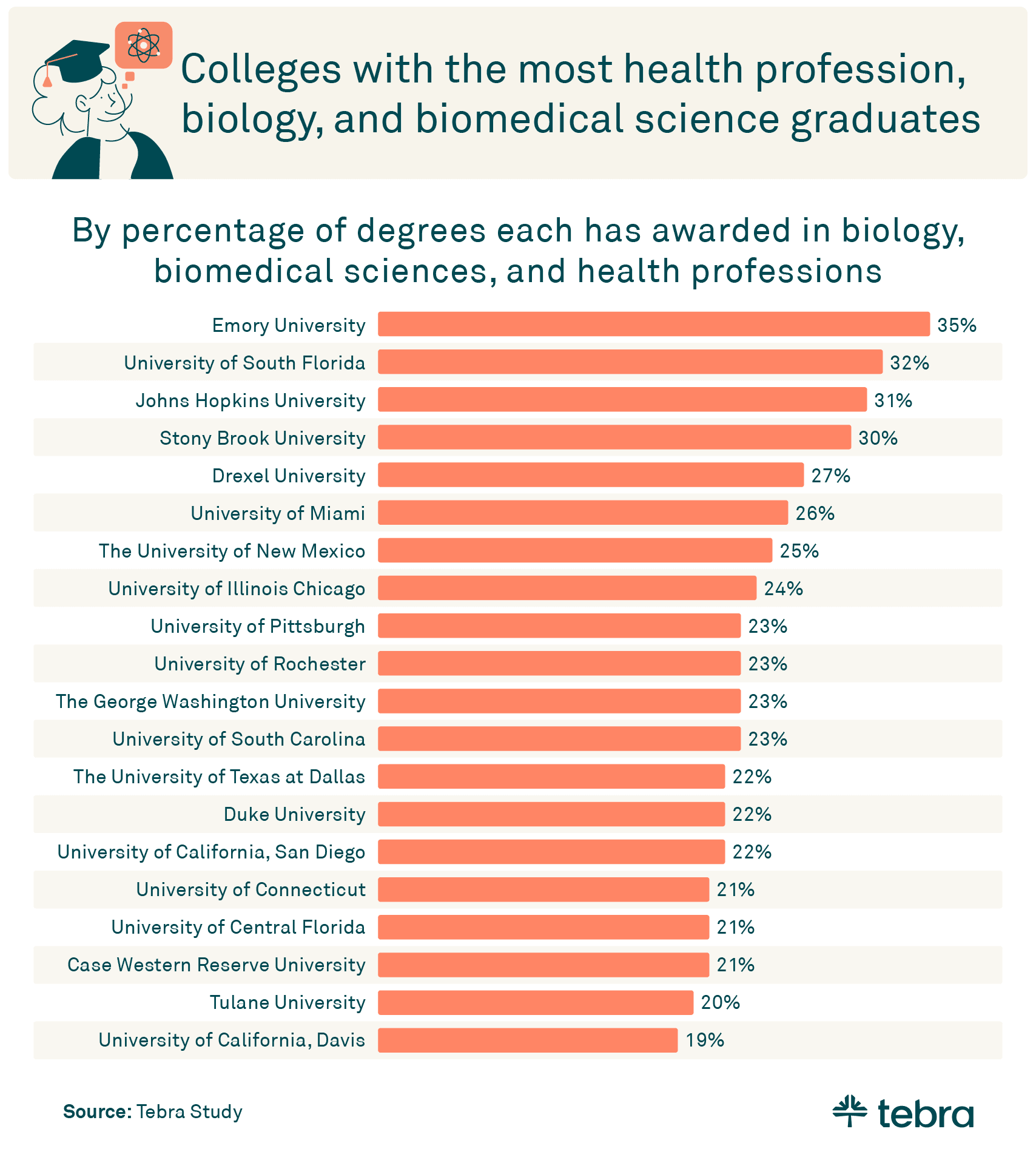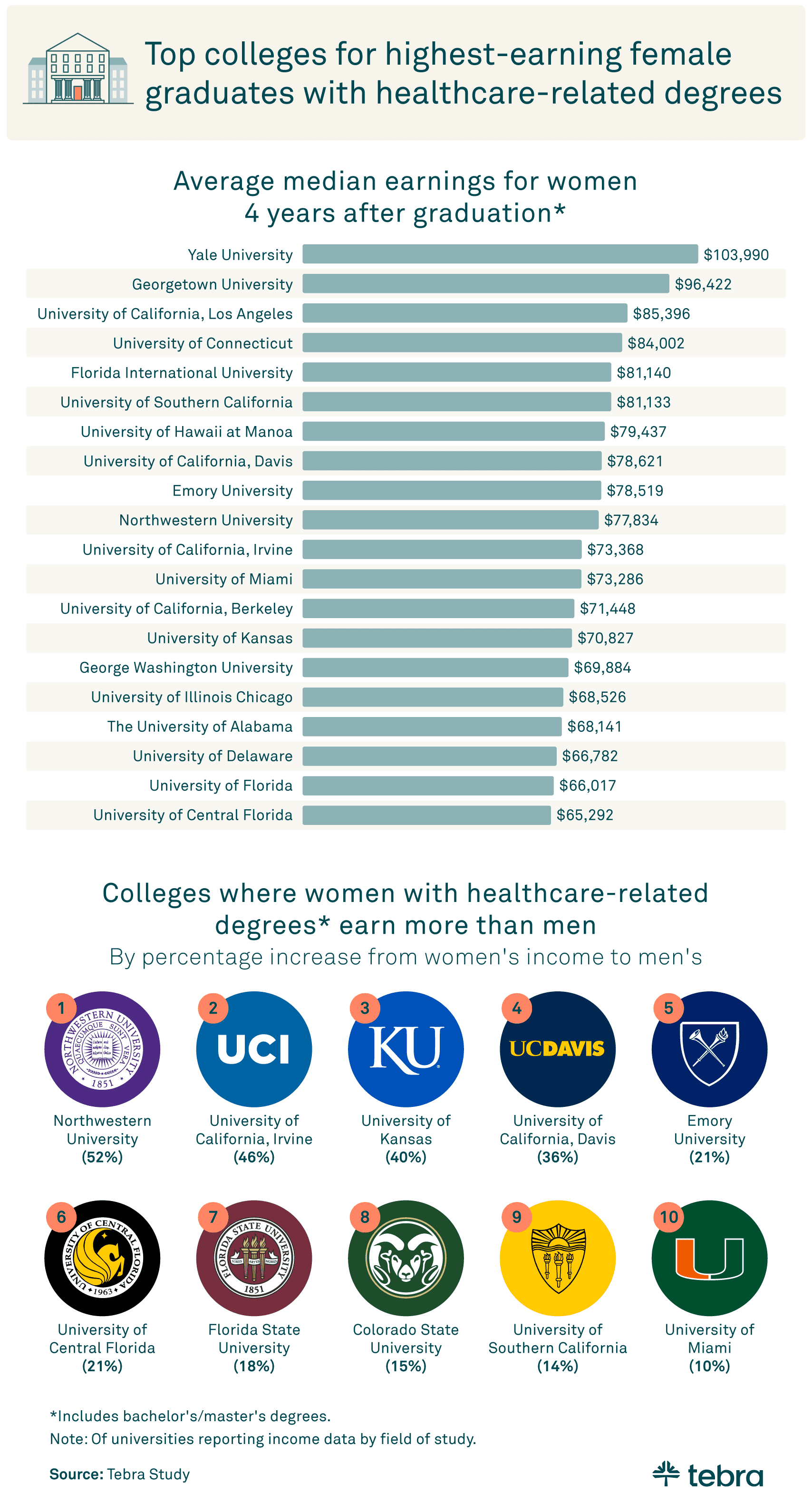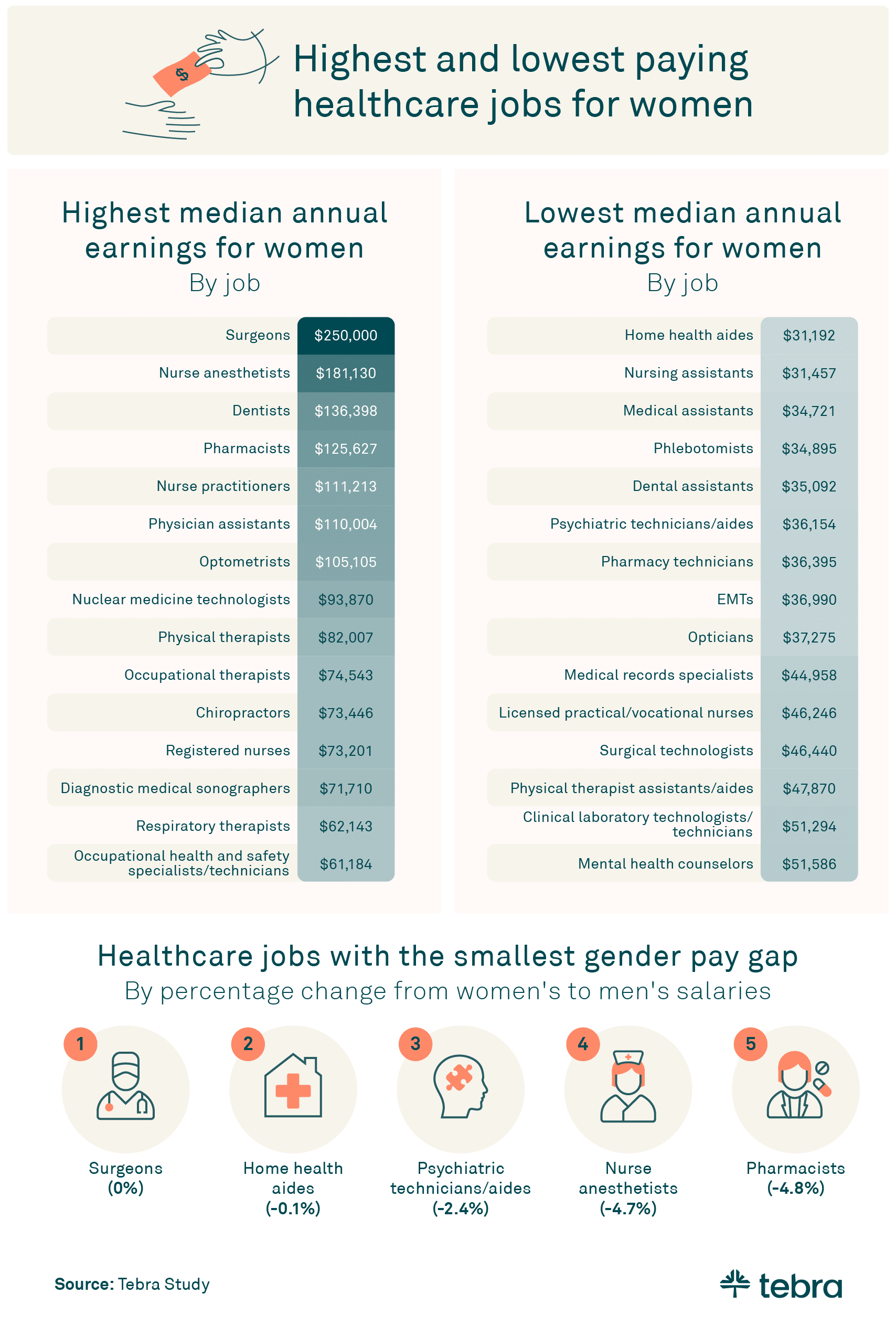This year, Equal Pay Day is March 24, 2024. Per the U.S. Department of Labor, the day is a reminder of systemic inequality faced by women and especially those of color. In the U.S., women who work full-time, year-round, are paid an average of 83.7 percent as much as men, which amounts to a difference of $10,000 per year. The gaps are even larger for many women of color and women with disabilities.
It’s a symbolic day that aims to raise awareness and combat pay inequities in the U.S. Ahead of this important marker, Tebra’s latest investigation looks into universities that are paving the way for high-earning female graduates in healthcare-related fields. Additionally, we explore healthcare jobs where women’s salaries are soaring. Tebra takes a comprehensive look at the educational institutions where female healthcare graduates earn more than their male counterparts and highlights the healthcare wage gaps across the U.S.
This analysis uses data from the U.S. Department of Education’s College Scorecard on QS World University’s top 100 universities and salary data from the U.S. Department of Labor.
Key takeaways
- Of the colleges analyzed in the study, the schools with the highest-earning women healthcare graduates are Yale University ($103,990) and Georgetown University ($96,422).
- Women with healthcare-related degrees from Northwestern University earn 52% more than their male counterparts.
- The highest-paying healthcare jobs for women are surgeons ($250,000) and nurse anesthetists ($181,130).
- Surgeons and home health aides have the smallest gender pay gap between men and women.
Top academic health hubs
Of 100 major U.S. colleges, we wanted to see which had the highest percentage of degrees awarded in biology, biomedical sciences, and health professions. Here are the top 20 universities.

The 5 colleges that have awarded the highest percentages of biology, biomedical sciences, and health profession degrees were all on the East Coast. Coming out on top was Emory University in Georgia, awarding 35% of such degrees. University of South Florida was next at 32%, followed by John Hopkins University (31%) — home to one of the top-ranked hospitals in the country.
While the top 5 colleges were concentrated on the East Coast, the presence of institutions like the University of New Mexico and the University of California, San Diego among the ranks showcases the geographical diversity and the widespread emphasis on health education across the U.S.
Salaries for women in health
Next, we looked at women’s median salaries 4 years after they completed a bachelor’s or master’s degree, averaged across various healthcare-related fields of study, to see which universities have produced the highest-earning women. The data illustrates a striking trend in the earning potential of female graduates.

Of schools analyzed, Yale University female graduates led with an impressive average median earning of $103,990 four years post-graduation. Women with healthcare-related degrees from Georgetown were close behind at $96,422. These figures are significantly higher than the national median earnings for healthcare professions, which was just under $78,000 per year at the time of this study.
Notably, Northwestern University stood out in another significant metric: female graduates with healthcare-related degrees from this institution earned 52% more than their male counterparts. These figures reveal the exceptional performance of these institutions in supporting successful careers for women in healthcare.
Which healthcare occupations pay women the most?
Now that we’ve looked at the schools from which women are most successful, we turn our attention to the occupations paying women the most in healthcare. Our analysis of U.S. Department of Labor data is detailed below.

Examining the healthcare industry’s financial promise for women, the roles that most significantly elevated their earnings were surgeons, who had median annual earnings at the quarter-million mark ($250,000). Nurse anesthetists also stood out with commendable earnings well above the six-figure threshold at $181,130. On the other end of the spectrum, home health aides earned the least, with a median salary of $31,192.
On the advancing front of gender equality, surgeon and home health aide roles showed the smallest gender pay gaps. Psychiatric technicians/aides, nurse anesthetists, and pharmacists all had less than 5% gender pay gaps. This suggests progress toward equitable pay and closing the gender pay gap in healthcare, at least in these two fields where there was almost no difference between men’s and women’s incomes. In contrast, America’s gender pay gap across all industries is nearly 18%, with women earning 82 cents for every dollar that men earn.
From academia to industry: Charting the path to parity in healthcare
Yale and Georgetown are among the universities equipping female graduates for the most lucrative careers — particularly in roles such as surgeons and nurse anesthetists. Meanwhile, other healthcare positions are showing only minor gender wage gaps. These findings reflect the high value of women’s contributions to healthcare, and a field of study that champions equality.
Methodology
Using the U.S. Department of Education College Scorecard, we analyzed the top 100 universities in the U.S. to see which colleges have awarded the highest percentage of degrees in health professions and biology/biomedical sciences. We then looked at median salaries earned 4 years after graduation, whether after a bachelor’s or master’s degree, in different healthcare-related fields of study to see which schools had the highest-earning post-grad women. The following fields of study were used:
- Biochemistry, biophysics, and molecular biology
- Biology, general
- Chiropractic
- Clinical psychology
- Dentistry
- Dental residency programs
- Foods, nutrition, and related services
- Health aides/attendants/orderlies
- Health and medical administrative services
- Health professions and related clinical sciences, other
- Health services/allied health/health sciences, general
- Health/medical preparatory programs
- Human biology
- Medical clinical sciences/graduate medical studies
- Medical residency programs, general certificates
- Medicine
- Mental and social health services and allied professions
- Optometry
- Ophthalmic and optometric support services and allied professions
- Pharmacy, pharmaceutical sciences, and administration
- Public health
- Registered nursing, nursing administration, nursing research, and clinical nursing
- Rehabilitation and therapeutic professions
We then gathered salary data from the U.S. Department of Labor on different healthcare-related occupations to see the highest paying occupations for women in healthcare.
About Tebra
In 2021, with a combined mission to unlock better healthcare, Kareo and PatientPop joined forces to form Tebra — a complete practice automation solution for independent healthcare providers. To learn more about how Tebra is committed to improving patients’ and providers’ success and well-being, visit www.tebra.com.
Fair use statement
All readers are welcome to share the findings presented in this article for non-commercial purposes only. When sharing, please provide a link back to this source.







